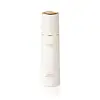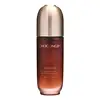What's inside
What's inside
 Key Ingredients
Key Ingredients

 Benefits
Benefits

 Concerns
Concerns

 Ingredients Side-by-side
Ingredients Side-by-side

Panax Ginseng Root Water
MaskingPropanediol
SolventGlycerin
Humectant1,2-Hexanediol
Skin ConditioningBetaine
HumectantCyclopentasiloxane
EmollientWater
Skin ConditioningPanax Ginseng Root Oil
Skin ConditioningPanax Ginseng Root Extract
EmollientGinsenosides
Skin ConditioningPoncirus Trifoliata Fruit Extract
Skin ConditioningAstragalus Membranaceus Root Extract
EmollientLycium Chinense Fruit Extract
AntioxidantLactobacillus/Soybean Ferment Extract
Skin ConditioningImperata Cylindrica Root Extract
Skin ConditioningGinkgo Biloba Leaf Extract
Skin ConditioningLeonurus Sibiricus Flower/Leaf/Stem Extract
SoothingPanthenol
Skin ConditioningCeramide NP
Skin ConditioningButylene Glycol
HumectantTromethamine
BufferingAcrylates/C10-30 Alkyl Acrylate Crosspolymer
Emulsion StabilisingCarbomer
Emulsion StabilisingAlcohol
AntimicrobialDisodium EDTA
Lecithin
EmollientCaprylyl Glycol
EmollientDipotassium Glycyrrhizate
HumectantEthylhexylglycerin
Skin ConditioningEthyl Hexanediol
SolventParfum
MaskingAlpha-Isomethyl Ionone
PerfumingCitronellol
PerfumingCoumarin
PerfumingLimonene
PerfumingLinalool
PerfumingPanax Ginseng Root Water, Propanediol, Glycerin, 1,2-Hexanediol, Betaine, Cyclopentasiloxane, Water, Panax Ginseng Root Oil, Panax Ginseng Root Extract, Ginsenosides, Poncirus Trifoliata Fruit Extract, Astragalus Membranaceus Root Extract, Lycium Chinense Fruit Extract, Lactobacillus/Soybean Ferment Extract, Imperata Cylindrica Root Extract, Ginkgo Biloba Leaf Extract, Leonurus Sibiricus Flower/Leaf/Stem Extract, Panthenol, Ceramide NP, Butylene Glycol, Tromethamine, Acrylates/C10-30 Alkyl Acrylate Crosspolymer, Carbomer, Alcohol, Disodium EDTA, Lecithin, Caprylyl Glycol, Dipotassium Glycyrrhizate, Ethylhexylglycerin, Ethyl Hexanediol, Parfum, Alpha-Isomethyl Ionone, Citronellol, Coumarin, Limonene, Linalool
Phellinus Linteus Extract
Skin ConditioningGlycerin
HumectantPEG-8
HumectantWater
Skin ConditioningButylene Glycol
HumectantPolyglycerin-3
HumectantAlcohol Denat.
AntimicrobialMethyl Gluceth-20
HumectantNiacinamide
Smoothing1,2-Hexanediol
Skin ConditioningMethylpropanediol
SolventPentylene Glycol
Skin ConditioningChlorella Vulgaris Extract
Skin ConditioningTheobroma Cacao Seed Extract
AntioxidantAngelica Gigas Extract
Skin ConditioningCornus Officinalis Fruit Extract
Skin ConditioningThymus Vulgaris Extract
PerfumingVelvet Extract
HumectantHelianthus Annuus Seed Oil
EmollientCandida Bombicola/Glucose/Methyl Rapeseedate Ferment
AntimicrobialHydrolyzed Hyaluronic Acid
HumectantMacadamia Ternifolia Seed Oil
EmollientPanax Ginseng Root Extract
EmollientGlucose
HumectantPEG-60 Hydrogenated Castor Oil
EmulsifyingGlyceryl Polyacrylate
Fructooligosaccharides
HumectantFructose
HumectantAmmonium Acryloyldimethyltaurate/Vp Copolymer
Octyldodeceth-16
EmulsifyingSodium Polyacrylate
AbsorbentEthylhexylglycerin
Skin ConditioningAdenosine
Skin ConditioningDextrin
AbsorbentSodium Phytate
Beta-Glucan
Skin ConditioningTocopherol
AntioxidantPolyglyceryl-10 Stearate
Skin ConditioningSodium Stearoyl Glutamate
Cleansing3-O-Ethyl Ascorbic Acid
Skin ConditioningCaprylyl Glycol
EmollientHydrolyzed Elastin
EmollientAcetyl Hexapeptide-8
HumectantCarbomer
Emulsion StabilisingCetearyl Alcohol
EmollientParfum
MaskingBenzyl Salicylate
PerfumingAlpha-Isomethyl Ionone
PerfumingCitronellol
PerfumingGeraniol
PerfumingLinalool
PerfumingCI 77480
Cosmetic ColorantPhellinus Linteus Extract, Glycerin, PEG-8, Water, Butylene Glycol, Polyglycerin-3, Alcohol Denat., Methyl Gluceth-20, Niacinamide, 1,2-Hexanediol, Methylpropanediol, Pentylene Glycol, Chlorella Vulgaris Extract, Theobroma Cacao Seed Extract, Angelica Gigas Extract, Cornus Officinalis Fruit Extract, Thymus Vulgaris Extract, Velvet Extract, Helianthus Annuus Seed Oil, Candida Bombicola/Glucose/Methyl Rapeseedate Ferment, Hydrolyzed Hyaluronic Acid, Macadamia Ternifolia Seed Oil, Panax Ginseng Root Extract, Glucose, PEG-60 Hydrogenated Castor Oil, Glyceryl Polyacrylate, Fructooligosaccharides, Fructose, Ammonium Acryloyldimethyltaurate/Vp Copolymer, Octyldodeceth-16, Sodium Polyacrylate, Ethylhexylglycerin, Adenosine, Dextrin, Sodium Phytate, Beta-Glucan, Tocopherol, Polyglyceryl-10 Stearate, Sodium Stearoyl Glutamate, 3-O-Ethyl Ascorbic Acid, Caprylyl Glycol, Hydrolyzed Elastin, Acetyl Hexapeptide-8, Carbomer, Cetearyl Alcohol, Parfum, Benzyl Salicylate, Alpha-Isomethyl Ionone, Citronellol, Geraniol, Linalool, CI 77480
Ingredients Explained
These ingredients are found in both products.
Ingredients higher up in an ingredient list are typically present in a larger amount.
1,2-Hexanediol is a synthetic liquid and another multi-functional powerhouse.
It is a:
- Humectant, drawing moisture into the skin
- Emollient, helping to soften skin
- Solvent, dispersing and stabilizing formulas
- Preservative booster, enhancing the antimicrobial activity of other preservatives
Alpha-Isomethyl Ionone is a fragrance. It can be synthetically created or naturally occurring.
The scent of Alpha-Isomethyl Ionone is described as "flowery" but can also be "woody".
Naturally occurring Alpha-Isomethyl Ionone may be found in Saccharomyces cerevisiae, or the yeast used to make wine and bread.
The term 'fragrance' is not regulated in many countries. In many cases, it is up to the brand to define this term. For instance, many brands choose to label themselves as "fragrance-free" because they are not using synthetic fragrances. However, their products may still contain ingredients such as essential oils that are considered a fragrance.
Learn more about Alpha-Isomethyl IononeButylene Glycol (or BG) is used within cosmetic products for a few different reasons:
Overall, Butylene Glycol is a safe and well-rounded ingredient that works well with other ingredients.
Though this ingredient works well with most skin types, some people with sensitive skin may experience a reaction such as allergic rashes, closed comedones, or itchiness.
Learn more about Butylene GlycolCaprylyl Glycol is a humectant and emollient, meaning it attracts and preserves moisture.
It is a common ingredient in many products, especially those designed to hydrate skin. The primary benefits are retaining moisture, skin softening, and promoting a healthy skin barrier.
Though Caprylyl Glycol is an alcohol derived from fatty acids, it is not the kind that can dry out skin.
This ingredient is also used as a preservative to extend the life of products. It has slight antimicrobial properties.
Learn more about Caprylyl GlycolCarbomer is a polymer of acrylic acid. Its main role is to create a gel consistency.
A high amount of carbomer can cause pilling or balling up of products. Don't worry, most products contain 1% or less of carbomer.
Citronellol is used to add fragrance/parfum to a product. It is often derived from plants such as roses. In fact, it can be found in many essential oils including geranium, lavender, neroli, and more. The scent of Citronellol is often described as "fresh, grassy, and citrus-like".
Since the Citronellol molecule is already unstable, Citronellol becomes irritating on the skin when exposed to air.
Citronellol is a modified terpene. Terpenes are unsaturated hydrocarbons found in plants. They make up the primary part of essential oils.
Citronellol is not able to be absorbed into deeper layers of the skin. It has low permeability,
Citronellol is also a natural insect repellent.
Learn more about CitronellolEthylhexylglycerin (we can't pronounce this either) is commonly used as a preservative and skin softener. It is derived from glyceryl.
You might see Ethylhexylglycerin often paired with other preservatives such as phenoxyethanol. Ethylhexylglycerin has been found to increase the effectiveness of these other preservatives.
Glycerin is already naturally found in your skin. It helps moisturize and protect your skin.
A study from 2016 found glycerin to be more effective as a humectant than AHAs and hyaluronic acid.
As a humectant, it helps the skin stay hydrated by pulling moisture to your skin. The low molecular weight of glycerin allows it to pull moisture into the deeper layers of your skin.
Hydrated skin improves your skin barrier; Your skin barrier helps protect against irritants and bacteria.
Glycerin has also been found to have antimicrobial and antiviral properties. Due to these properties, glycerin is often used in wound and burn treatments.
In cosmetics, glycerin is usually derived from plants such as soybean or palm. However, it can also be sourced from animals, such as tallow or animal fat.
This ingredient is organic, colorless, odorless, and non-toxic.
Glycerin is the name for this ingredient in American English. British English uses Glycerol/Glycerine.
Learn more about GlycerinLinalool is a fragrance and helps add scent to products. It's derived from common plants such as cinnamon, mint, citrus, and lavender.
Like Limonene, this ingredient oxidizes when exposed to air. Oxidized linalool can cause allergies and skin sensitivity.
This ingredient has a scent that is floral, spicy tropical, and citrus-like.
Learn more about LinaloolGinseng root is a well-loved ingredient in Asian skincare for good reason. It hydrates the skin, soothes irritation, and helps even out skin tone.
In traditional East Asian medicine, ginseng has been used for centuries both as food and as a healing remedy, and modern research continues to confirm its skin benefits.
One of the standout features of ginseng is its ability to improve blood circulation and oxygen delivery to the skin, bringing a fresh supply of nutrients to support overall skin health. It also has antioxidant and anti-inflammatory properties. This helps to protect your skin against damage from UV exposure, pollution, and daily stress.
Additionally, studies suggest that ginseng may help reduce hyperpigmentation by inhibiting tyrosinase, the enzyme involved in melanin production.
There are different types of ginseng used in skincare, and while they all share core benefits, their potency can vary.
Most products use fresh or white ginseng because it’s more affordable. However, red ginseng, produced by steaming the root, contains higher levels of ginsenosides, which are compounds with proven anti-aging effects. These ginsenosides help reduce the appearance of wrinkles and improve skin elasticity.
Note: All forms of ginseng are listed simply as “Panax ginseng” in ingredient lists. We recommend reaching out to the brand if you have questions about which type of ginseng is used in their ingredients.
For general antioxidant benefits, any ginseng extract will do, but for wrinkle care or firmer skin, red or fermented ginseng is often more effective.
In short, ginseng is a powerhouse ingredient that supports hydration, radiance, and resilience.
Learn more about Panax Ginseng Root ExtractParfum is a catch-all term for an ingredient or more that is used to give a scent to products.
Also called "fragrance", this ingredient can be a blend of hundreds of chemicals or plant oils. This means every product with "fragrance" or "parfum" in the ingredients list is a different mixture.
For instance, Habanolide is a proprietary trade name for a specific aroma chemical. When used as a fragrance ingredient in cosmetics, most aroma chemicals fall under the broad labeling category of “FRAGRANCE” or “PARFUM” according to EU and US regulations.
The term 'parfum' or 'fragrance' is not regulated in many countries. In many cases, it is up to the brand to define this term.
For instance, many brands choose to label themselves as "fragrance-free" because they are not using synthetic fragrances. However, their products may still contain ingredients such as essential oils that are considered a fragrance by INCI standards.
One example is Calendula flower extract. Calendula is an essential oil that still imparts a scent or 'fragrance'.
Depending on the blend, the ingredients in the mixture can cause allergies and sensitivities on the skin. Some ingredients that are known EU allergens include linalool and citronellol.
Parfum can also be used to mask or cover an unpleasant scent.
The bottom line is: not all fragrances/parfum/ingredients are created equally. If you are worried about fragrances, we recommend taking a closer look at an ingredient. And of course, we always recommend speaking with a professional.
Learn more about ParfumWater. It's the most common cosmetic ingredient of all. You'll usually see it at the top of ingredient lists, meaning that it makes up the largest part of the product.
So why is it so popular? Water most often acts as a solvent - this means that it helps dissolve other ingredients into the formulation.
You'll also recognize water as that liquid we all need to stay alive. If you see this, drink a glass of water. Stay hydrated!
Learn more about Water